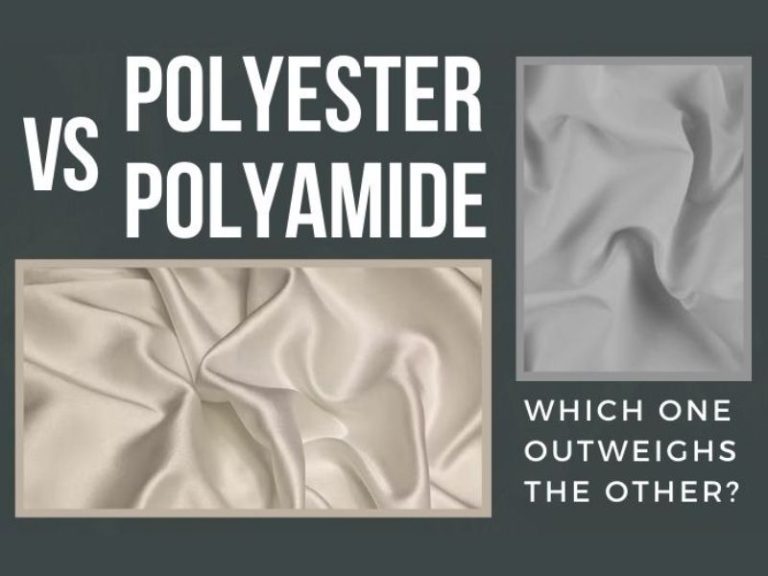How To Keep White Sheets White, fresh, and pristine like that? As the saying goes, “White sheets are like life’s canvas, every stain tells a story.” Whether it’s a splash of coffee in the morning, a smear of chocolate at midnight, or the oils from our skin, it doesn’t take much to ruin that perfect white sheets.
Multiple tricks are up their sleeves to keep all sheets sparkling white, ranging from special detergents to bleaching techniques. But there is still something to surprise you in keeping these beddings whitish. Dig deeper into this post to unfold more tips and tricks for your command!
Why Do White Sheets Turn Yellow or Gray?
Over time, many of us notice a disheartening shift from bright white to a dull yellow or gray.
Common reasons behind discoloration:
- Body Oils and Sweat
- Lotions and Skincare Products
- Laundry Detergents and Bleach
- Aging of the Fabric
- Sun Exposure
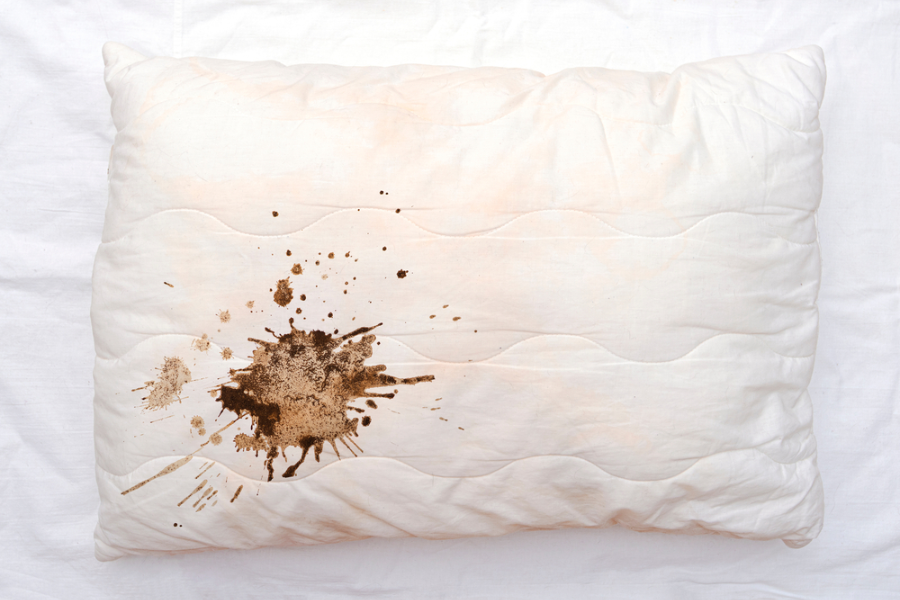
The Science Behind Fabric Discoloration
The primary offenders causing our beloved sheets to lose their luminous white hue are body oils, sweat, and skincare products. Our skin naturally produces oils, and combined with the sweat we release during sleep, these can accumulate on our sheets. Lotions, creams, and even certain hair products can leave residues that, over time, stain and alter the color of the fabric. It’s estimated that an average person can sweat up to a liter per night. Over weeks, imagine the volume of perspiration our sheets absorb!
At a microscopic level, these body oils and sweat can cause a reaction with the fabric, leading to oxidation. This oxidation, in simple terms, is a chemical reaction where the fabric fibers interact with the oils and air, leading to a color change, much like how an apple turns brown when left out. This reaction is more pronounced in white sheets, making discoloration evident.
Fabric Types and Their Tendency to Discolor
Different fabrics react differently to body secretions and cleaning methods. For instance:
- Cotton: Highly absorbent and tends to hold onto oils, making it prone to yellowing. Generally, natural fibers like cotton ,linen can retain their original color for about 2-5 years.
- Linen: Natural and breathable but can gray over time, especially if washed with hard water.
- Microfiber: Less likely to stain from oils, but certain detergents can cause it to gray. Synthetic fibers such as polyester, nylon, and acrylic have a longer duration, typically lasting between 5-10 years before showing signs of discoloration.
Influence of Fabric Type on Cleaning
The stain resistance and best method of washing for any given fabric are both product of the fabric’s specific make-up. Bleach, for instance, may do wonders for cotton but can be quite damaging to the synthetic fibers used to make microfiber sheets. In addition, linen often requires milder cleaning procedures than the more durable cotton.
The choice of cleaning fluid matters. Some detergents and fabric softeners contain chemicals that might hasten the discoloration process. Moreover, direct exposure to sunlight and UV rays accelerates fabric discoloration. Extended exposure to direct sunlight can cause white sheets to yellow.
In summary, even if our sheets may be the unseen victims of daily deterioration, knowing the causes of their fading and the subtle differences between various materials may help us maintain their finest appearance. After all, cleanliness begins with knowledge.
How To Keep White Sheets White In The Right Way?
White sheets may be kept looking fresh with the help of the correct methods and materials. If you want your white linens to seem clean and crisp for as long as possible, follow these steps.
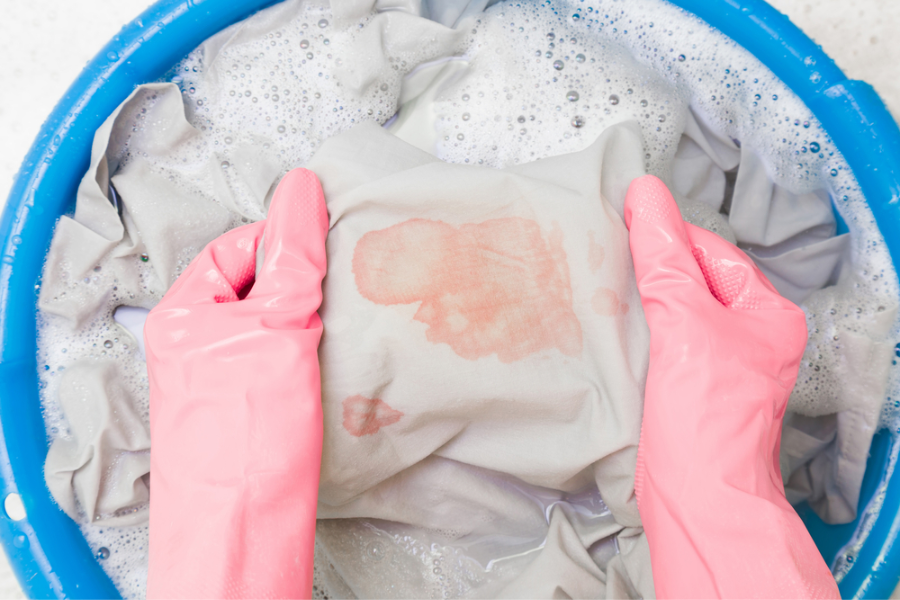
1. Water Temperature: Hot or Cold?
This is the first criteria that everyone need to pay attention in cleaning white sheets.
- Hot Water: Hot water is effective in removing germs, allergens, and heavy soil from sheets. It’s especially recommended if someone has been sick or if the sheets haven’t been washed for a while. However, frequent washing in hot water can weaken fibers over time, leading to wear and tear.
- Cold Water: Cold water is gentler on fabric fibers and is energy-efficient. Modern detergents are formulated to work well in cold water. However, it might not be as effective in removing certain stains or germs.
Recommendation: For regular washing, cold water is sufficient. However, for deep cleaning or sanitizing, especially during illness, hot water is preferable.
2. Detergent Selection: Which Ones are Best for White Sheets?
- Powdered Detergents: They are typically more cost-effective and can be better at removing mud or clay-based stains.
- Liquid Detergents: These are great for spot-treating stains. They dissolve well in cold water and are less likely to leave residue.
- Detergents with Optical Brighteners: These are chemicals that reflect blue light, making whites appear whiter. They don’t necessarily remove stains but give an illusion of brightness.
- Bleach: While bleach can be effective in making whites whiter, it’s harsh and can weaken fabric fibers. If you must use bleach, ensure it’s non-chlorine or oxygen bleach, which is gentler.
Recommendation: Using high-quality liquid detergent without added dyes or fragrances. If the sheets are heavily soiled, consider a detergent with enzymes. Use bleach sparingly and only when necessary.

3. Understanding the Pros and Cons of Using Bleach
Understanding the pros and cons of bleach can help users make informed decisions about when and how to use it safely and effectively.
| Aspect | Pros of Using Bleach | Cons of Using Bleach |
|---|---|---|
| Effectiveness | – Powerful disinfectant against pathogens. | – Can weaken and damage fabric fibers. |
| Appearance | – Restores brightness to white fabrics. | – Can cause yellowing in whites and fade colored fabrics. |
| Usability | – Long shelf life. | – Releases toxic fumes; needs ventilation. |
One of the primary benefits of bleach is its ability to kill bacteria, viruses, fungi, and other pathogens. Bleach can break down many organic compounds, making it effective at removing a wide range of stains, especially on white fabrics.
However, overuse or incorrect use of bleach can weaken fibers, leading to premature wear and tear of fabrics. While bleach is known for its whitening effect, it can also cause discoloration, especially on colored fabrics.
How Can Daily and Weekly Habits Keep Your Sheets White?
Here’s a comprehensive guide to ensure your sheets remain as white as the day you bought them:

Note 1: Making the Bed Daily
Making your bed daily helps smooth out wrinkles, which can trap dirt and oils. It also prevents dust and pollutants from settling on the sheet’s surface.
- Detailed Steps:
- Pull the sheets tight to ensure there are no folds where dirt can accumulate.
- Shake out your sheets and blankets to remove any dust or particles.
- Fluff your pillows daily to keep them fresh and free from dust.
- Use handy vacuum to collect all the dust, hair and particles on the sheet.
Note 2. Weekly Washing Tips
While it might be tempting to wash your sheets less often, it’s advisable to wash them weekly. This frequency ensures body oils, sweat, and other residues don’t have time to set in and discolor the fabric.
Overloading the washing machine means the sheets don’t have enough space to move around. This can lead to inadequate cleaning and even cause the sheets to become tangled or stretched. Remember, load the washing machine to no more than three-quarters full. This ensures effective cleaning and reduces wear on your sheets.
This is the schedule for washing that help you keep track of your monthly cleaning:
| Bedding Item | Recommended Washing Frequency |
|---|---|
| Sheets | Every 1-2 weeks |
| Blanket | Every 2 weeks or when visibly dirty |
| Pillowcases | Every 1-2 weeks (same as sheets) |
| Pillows | Every 3-6 months |
| Comforter/Duvet | Every 2-3 months or as seasons change |
Note 3. Drying Before Using
Proper drying of sheets keeps them clean and avoids the formation of mould and mildew that can cause discolouration. If line drying, avoid prolonged exposure to direct sunlight, as this can weaken fibers and cause yellowing. And If using a dryer, opt for a low to medium heat setting. Remove sheets promptly to prevent wrinkles.
Our Comprehensive Guide : Dealing with Stubborn Stains
Stains on your favorite clothes or bedding can be a nightmare, these stubborn marks often resist regular washing. However, with the right approach, most stains can be effectively tackled. Here’s a detailed guide on dealing with stubborn stains:
- Pre-treat Stains:
Pre-treating focuses on the specific area, ensuring that the cleaning agents act directly on the stain rather than being diluted in a wash cycle.
- Identify the Stain: Different stains require different treatments. For instance, protein-based stains (like blood) and tannin-based stains (like coffee) have distinct cleaning needs.
- Choose the Right Cleaning Solution: Base on the stain, we can decide using liquid detergent, baking soda, vinegar, or just commercial stain remover.
- Apply the Solution: Apply the cleaning solution gently, start with small area. Then, allow the solution to sit on the stain for a specified time (this could range from a few minutes to overnight).
Expert’s Warning
Read Care Labels: Some fabrics may have specific care instructions or warnings against certain cleaning agents.
- Spot Treatment Techniques for Common Stains:
- Chocolate: Remove excess chocolate by gently scraping it off. Then, run cold water through the back of the stain. Apply a mixture of dish soap and cold water to the stain, rub it gently, and then wash.
- Blood: Rinse immediately with cold water. Apply hydrogen peroxide (for white fabrics) or salt (for colored fabrics) to the stain. Rinse again and then wash.
- Wine: Blot (don’t rub) the stain immediately with a clean cloth to absorb as much liquid as possible. Sprinkle salt over the stain to absorb the wine. Later, apply a mixture of dish soap and hydrogen peroxide to the stain before washing.
- Coffee: Blot the stain with cold water immediately. Then, apply a mixture of liquid laundry detergent and vinegar. Rinse with cold water and wash.
- Dirt, Mud: Let the dirt dry completely. Then, brush off as much dried mud as you can. Apply a few drops of liquid laundry detergent directly to the stain.
- Chilli Oil: Wash the garment in the hottest water safe for the fabric. Do not rub, as this can spread the stain. Apply a few drops directly to the stain and gently rub the fabric together.
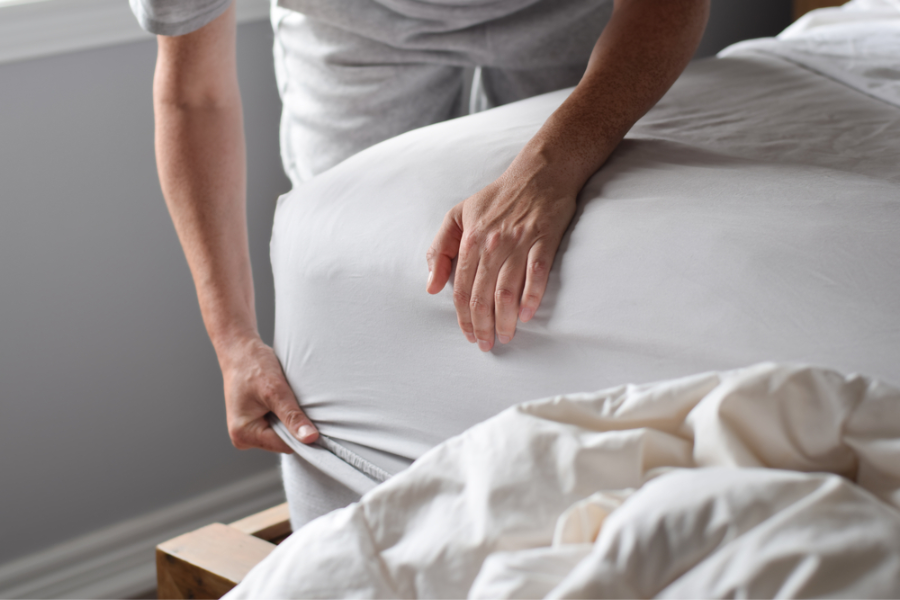
How Do Hotels Maintain Their Sheets White and Clean?
Opinions may vary, but anyway, you need more than just some hot water and bleach.
Each hotel chain approaches the daily laundry avalanche in their establishments differently.
Most of them offer laundry stain removal services. Rather than reaching for the bleach, they use cutting-edge solutions like stain removers and specialty soaps or skincare products. Or they might employ a large pot filled with laundry detergent, baking soda, and cold water to clean the linens. Then, the linens are boiled for half an hour and patted dry.
In other cases, after treating the bedding, hotels use a three-step procedure to wash them. They use laundry detergent to clean before running another cycle with fabric softeners. Bleach is the final step to restoring the white hue.
Hotels routinely favor washing them in the cold over hot water. Hot water breaks down the materials faster, squandering money over the long haul for such daily-wash bedding.
Laundry detergent and washing technologies, along with the inclusion of skin care products, are top priorities in many hotels. These innovative approaches help reduce labor, water, and energy requirements, all while maintaining the cleanliness and whiteness of their sheets.
In the case of Sonic Soak, for instance, modulated ultrasonic waves can disintegrate even the tiniest stains and debris. They save time and energy while washing clothes, too.
How To Whiten My Sheets Like A Hotel?
Professional Cleaning Devices
Investing in industrial-sized washing machines is good to go to minimize the chances of wear and tear for linens. Search for the best equipment that can meet your needs and your financial status.
Bleach & Peroxide Detergent Usage
Peroxide-based detergents are one of the hotel industry’s best-kept secrets for ensuring the linens’ cleanliness. Mixing with bleach is another step.
Though this prevents white linens from turning gray or yellow, they call for some training and experience.
Improper usage can ruin your bedding because bleach is particularly tricky to work with due to its harsh nature. In the worst scenario, you could damage the fibers and make bed sheets tear more easily.
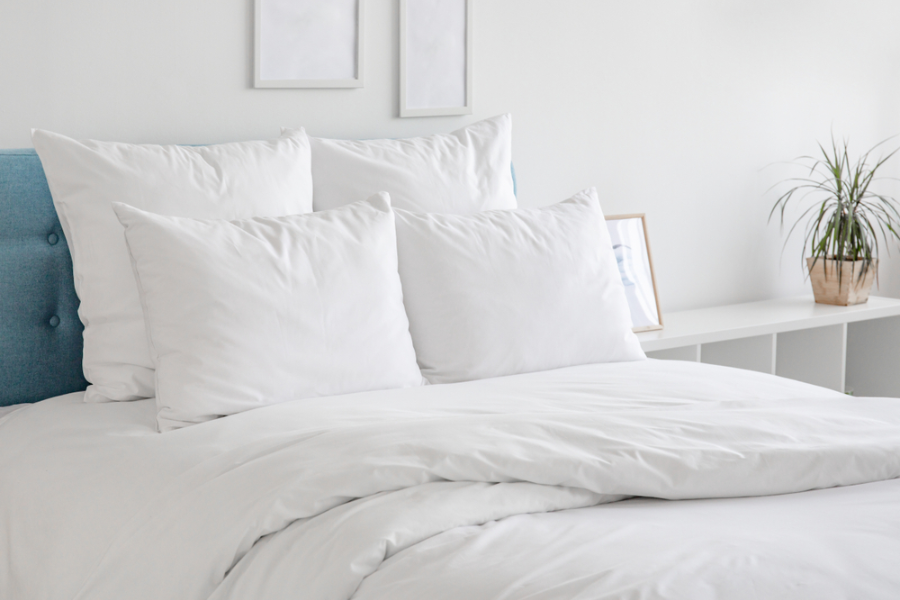
Proper Cleaning, Drying, And Storage
Have your white sheets cleaned once a week at least to get rid of all body oil timely. This way hinders your bedding sheet from turning yellow. Occasionally, graying or dulling can occur over time if dirt and grime are not eliminated from the fabric using proper detergents.
It’s also a colossal shortcoming if you overlook the storage and drying steps. Try to preserve the sheets’ material integrity with correct drying or even a cutting-edge textile-drying process. After that, store them to stay away from moisture to hinder mold development.
Hire A Professional Service Provider
The high-end hotel linen services have the resources to handle even the most complex parts of linen care, from laundering to repairs. This way may cost you significantly more than other ways, yet their quality is out of the question. Seek and go for state-of-the-art facilities and a highly trained textile care team to ensure that your whites are always clean, soft, durable, and ready to use.
FAQs
Most hotels wash their bed sheets once a week, which is also the expert’s recommendation, yet this frequency can vary based on the hotels. Following their policies and procedures, some regularly change their linens every three days, while others only do so at the guests’ request.
Your white sheets may gradually turn yellow due to sweat and body oil, including the lotions or other skincare products you use while sleeping. Wash them as often as you can, ideally every 4-5 days, to keep your white sheets from turning yellow.
It’s up to the hotels. The sheets and pillowcases should be laundered during each guest’s stay. Most change sheets between guests, including Hilton hotels. Still, many don’t do so; check your bedding sparingly before moving into any hotel room.


